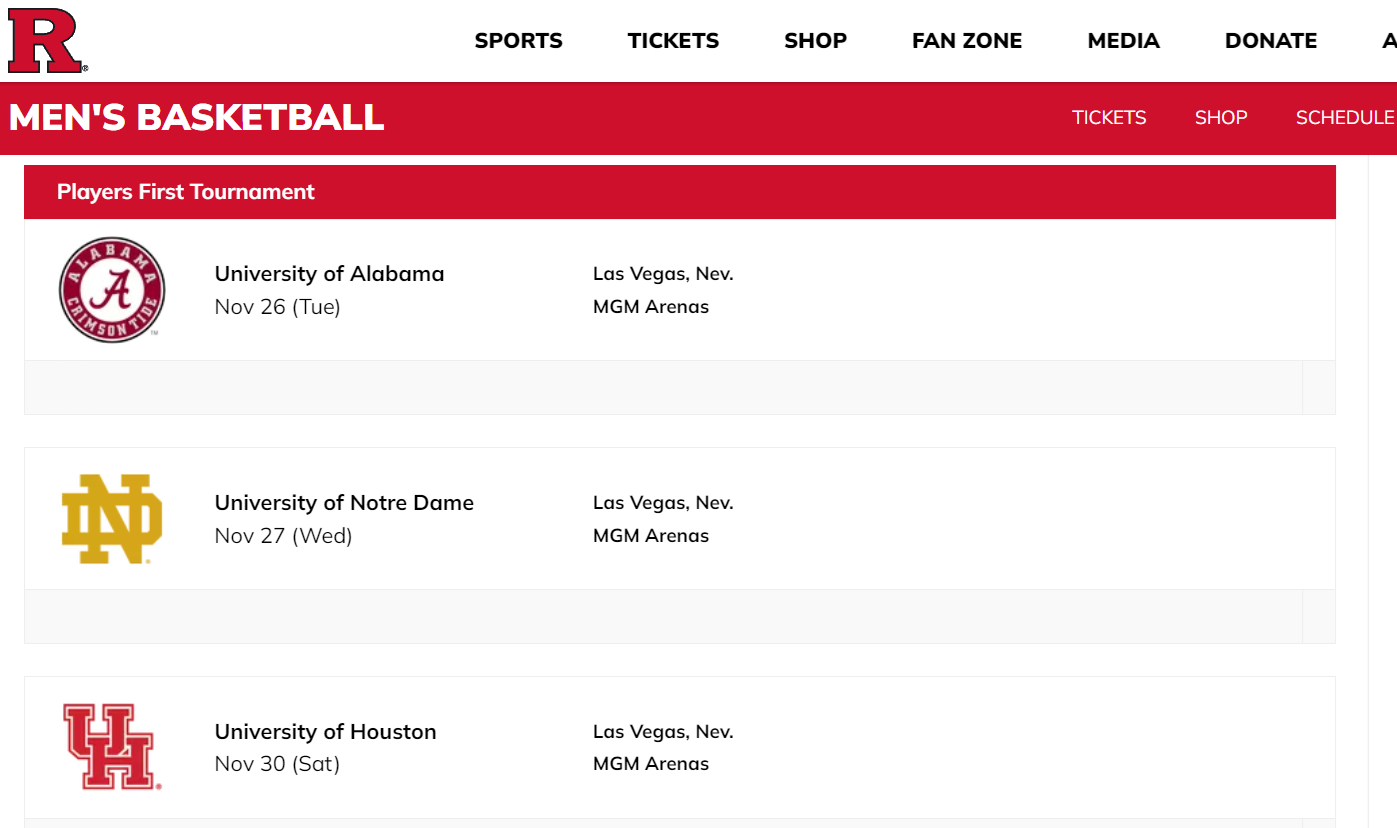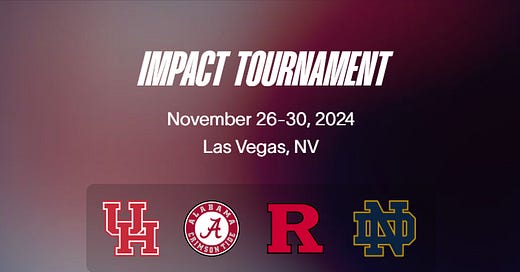Separating fact from fiction with the NIL-driven Players Era Festival
Rutgers will participate in a new multi-team event in November with bold ambitions to get players NIL payments.

The inaugural multi-team event known as the Players Era Festival released its schedule the other day, with 11 weeks to go before the first tip-off in Las Vegas. Rutgers is scheduled to face Notre Dame, Alabama and Houston – or was it Alabama first, then Notre Dame? Either way, the innovative new tournament is scheduled for Nov. 26, 27 and 29 – sorry, 30, not 29, as was previously reported.
Rutgers on Tuesday released and promptly took down a social media graphic that showed Alabama as its first opponent in Vegas. It also had the first two opponents flipped on its schedule for a while (screen-grabbed below) before they were corrected. Since it was incorrect in more than one place, it’s possible tournament organizers may have given Rutgers wrong information behind the scenes.

So the Players Era Festival had a bumpy schedule rollout. Who cares? It’s a new in-season tournament, captained by a company without prior experience in the college basketball event management space. We all make mistakes.
It wouldn’t set off any real alarm bells if not for the rumors online that the whole event is a scam, or, more plausibly, that it was in danger because the NCAA wanted to thwart its bold objective of dishing out millions of dollars in name, image and likeness money to athletes.
Let’s back up. The concept of the Players Era Festival has been bubbling up through media reports, primarily from CBS Sports’ Matt Norlander, since at least May of this year. The production company behind the project, EverWonder Studio (and its subsidiary, Players Era), didn’t exist 15 months ago. It’s backed by private equity and has partnered with MGM Resorts and Warner Bros. Discovery.
The idea of the Players Era Festival is to put on a regular-season tournament in Las Vegas, the way many teams head to the Bahamas or Maui or Florida for games during “Feast Week,” but with the key twist that participating schools would take home NIL money for their players. If that sounds like pay-for-play, Players Era wants to assure you that it’s not. From their website:
The Players Era Festival is committed to providing $9 million in NIL to college basketball players in 2024 for their engagement in activities separate and apart from competition, and more than $50 million in NIL over the next three years. For these NIL payments, players will perform services and activities fully compliant with current NCAA regulations.
That breaks out to $1 million per school, paid to their affiliated NIL collectives, and another $1 million available to players. CBS reported in May that the final $1 million in NIL opportunities was earmarked for “the winner or winners of the event,” but that language isn’t popping up in this month’s media reports about the festival.
So when you see headlines like the one below, making it sound like Dylan Harper and Ace Bailey could be walking out of Vegas with personal checks for up to $9 million, understand that that’s a bogus misinterpretation from a generally bogus source.
Now, college hoops fans got anxious waiting for Players Era to announce its final agenda. Its website went down for a spell earlier this month, leading to rumors of “fraud” and comparisons to the Fyre Festival scam of 2017. It’s quite likely the company was still lining up its venue (MGM Grand Garden Arena) and TV broadcast windows before the belated announcement.
However, a memo from the NCAA in August gave us real reason to wonder if the Players Era Festival was going to be permissible at all.
There are multiple prongs to this. The most obvious one concerns the appearance of pay-for-play.
Q: Is it permissible for an event operator, event sponsor or another institution to pay a collective, which, in turn compensates student-athletes?
A: No. It is impermissible for student-athletes to receive compensation directly or indirectly for participating in an athletics competition. As a result, event operators, event sponsors and institutional opponents may not pay an NIL entity (e.g., collective) for a competition in which student-athletes participate. … However, an institution may make arrangements with an event operator for student-athletes to engage in NIL activities during ancillary events (e.g., autograph session, community service) provided student-athletes actually engage in NIL activities separate and distinct from participation in the event.
This is why Players Era uses the language “separate and apart from competition” on its About Me page. They go on to promise “financial education programs and multiple on-call NIL opportunities for players.” Bet on Harper and Bailey signing a ton of autographs during their week in Vegas.
The NCAA memo also asked and answered the question of whether teams from the same conference can play in the same MTE.
A: No. Even if the MTE is structured in such a way (e.g., divisions/brackets) in which two teams from the same conference will not play each other, two teams from the same conference may not participate in the same MTE.
Dear reader, it took me several moments of staring at the list of participating teams before I spotted the conference rivals: Oregon and Rutgers, naturally. (Alabama and Texas A&M, too. Hard to believe they’ve been SEC opponents for 12 years now.)
So how will Players Era wriggle out of this one? It’s not enough for Rutgers to avoid playing Oregon and Alabama to avoid A&M. I believe they’re framing the two groups of four as their own separate MTEs, the “Impact Tournament” that Rutgers is in and the “Power Tournament” featuring Creighton, Oregon, Texas A&M and San Diego State. Time will tell if that’s enough to skirt the bylaws.
The teams are a mixture of great modern-day basketball programs, big athletic brands like Oregon and Notre Dame and an upstart with future NBA stars in Rutgers. You notice that Players Era didn’t land a Kansas-style blueblood, or even a school on the Michigan State tier; they’re harder gets, already in demand for tournaments like Maui years in advance.
Yet Players Era is shooting for the moon with some of its promises. It pledges “more than $50 million in NIL” in a three-year span. It wants to expand to 18 teams in 2025 – that’s more than 20 percent of the power-conference basketball world. “After the 2025 event grows to 18 teams, adding even more is not out of the question,” Front Office Sports breathlessly declared. Commits for 2025 include the likes of Gonzaga, Michigan and Syracuse.
The publication I’ve seen apply the healthiest amount of skepticism is Sportico. In their most recent story on the festival Tuesday, they talked to two high-ranking officials with MTE experience, including Gazelle Group president Rick Giles.
“Their math doesn’t work based upon the market,” Giles said. “Their expenses will be over $10 million and their revenues will be considerably less. So somebody will have to fund a deficit in the range of $9 million to ensure that the players get paid.”
It’s fair criticism, but it’s worth remembering that it’s coming from a direct competitor of Players Era, motivated to publicly cast doubt that players at Rutgers and elsewhere will even get their NIL checks. Giles doesn’t want the MTE space so thoroughly disrupted. (As someone who attended two Gazelle-organized games last season and saw that they were not willing to put out so much as bottles of water for the credentialed media, I get the sense that some groups keep their purse strings tighter than others. But I’ll leave my personal axe to grind there.)
Where does that leave us?
I’m neither pro-Players Era or anti-Players Era (though the way they drape themselves in progressive-sounding buzzwords like calling their MTEs the “Power” and “Impact” tournaments makes me gag). And don’t mistake this post for a diatribe against players making NIL money in general. I firmly believe that athletes should be able to earn what the market says they’re worth.
As for November in Las Vegas, no doubt those games will be played. In the worst-case scenario, the NCAA may rule that the Players Era Festival does not count as an MTE by its bylaws, and “all contests in the event must count towards each participating team’s maximum 29 contest limit.”
I’m much more skeptical that Players Era will put on an 18-team tournament a year from now, even if the pilot year goes off smoothly. For what it’s worth, Sportico reported that EverWonder can pay NIL collectives a termination fee of $250,000 in the event it is “unable to operate any or all of the 2024 event, the 2025 event or the 2026 event.”
Maybe that’s the backdoor that makes the risk palatable for Rutgers and the other schools. The Scarlet Knights hope the tournament goes off as advertised and they get a big bump in national exposure that helps on the recruiting trail. If it falls apart, they still pocket a nice sum for the collective and get Alabama on the phone to schedule a one-off road game in its place.
………
Hey, I’m back! Thanks for reading. The mystery swirling around this “festival” was enough to get me to dust off the ol’ Substack and take a stab at synthesizing all of the information floating around out there.
Season 4 of Guarden State will launch in October. My plans remain in the works (since teams like Rutgers and Seton Hall don’t even know their own conference schedules at this point), but I do intend on keeping the majority of my articles free once again. Spread the word if people in your life are interested in New Jersey college hoops. Talk to you soon.



